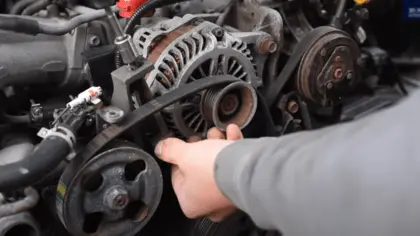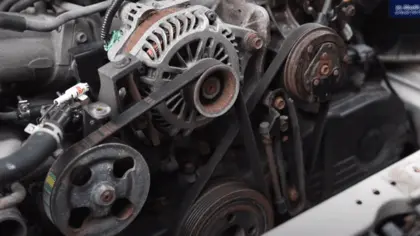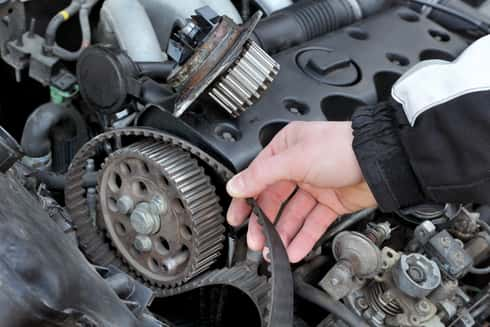Usually, you would need a Subaru timing belt replacement after 90,000 miles. However, it doesn’t always take that long.
There could be oil leaks from your vehicle’s engine, and a replacement would be needed fast.
Several individual components around the timing belt might require replacement as you deem fit. and having no idea of what goes, and when can be a potential problem.
But not to worry, this piece is going to discuss everything you need to know about the Subaru camshaft timing belt replacement.
Subaru Timing Belt Replacement: the Installation Procedure

Replacing the Subaru timing belt requires you to be well-informed about the process. this section gives a detailed walkthrough on how to go about it.
Step 1: Drain the Coolant
The first thing you’ll have to do is to remove the radiator cap. You can’t do this when the vehicle has just finished running. A cool radiator is best to work with.
Then, draining the coolant comes next. Pull out the drain plug from beneath the vehicle. You can easily place a container beneath the vehicle to collect the coolant from the radiator.
While the coolant is being drained, you should attempt to remove the intake duct. Tools might not be necessary at this stage.
Hands can easily do the work; pulling the two clips and securing the hood in place.
Step 2: Undo the Radiator Mounts
With that out of the way, you can proceed to take off the hood prop and the top radiator as well as the belt cover.
Get your tools ready as you proceed. Next are the radiator mounts. you would need a 12mm socket to undo the bolts putting them in place.
Now that the radiator itself is undone. The fans come next. Don’t forget to disconnect the wires on the sides while working out the fans.
Step 3: Remove the Radiator
What is left is the bottom radiator hose. It’s not that difficult. You’ll almost be repeating the procedure for taking the hose on the top. Get your pliers ready.
Take off the clamp, and preferably leave it on the radiator side. There will be some more coolant to drip off this pipe so make sure you have a container ready to collect what comes out.
Now you can pull out the radiator easily. Do so and set it aside.
Step 4: Uncover the Timing Belt
Once the whole radiator unit comes out, you’re left with the power steering and the air conditioner belts. To tackle this phase, you have some unmounting to do.
Undo the bolts that mount the alternators.
Now you need to remove the covers that conceal the timing belt and its components. There is a big cover and a smaller one.
Also, there are a handful of bolts to remove from the bigger cover and three bolts from the smaller one. This shouldn’t take much of your time.
When all the bolts are loosened and the covers are off, you’ll now be able to see the timing belt.
Now there is an important thing to take note of. You need to put the engine at the dead top center. To do this, pull out a suitable tool and turn the engine till it’s at the top dead center.
Although you can see the timing belt, you won’t be able to access it yet. The tensioner will get in your way and you need to get it off first.
Remove the tensioner with a 14mm socket.
There’s also a need to remove the guide from the crank sprocket. Use a 10mm socket to remove the bolts required to remove the guide.
Step 5: Replacing the Timing Belt
Replace the tensioner by screwing a new one tight in place and prepare to install the Subaru timing belt replacement.
While you hold the timing belt you’ll realize that there are three markings on it. Make sure that the marking in the far right goes to the cam, and the marking in the middle to the crankshaft.
The markings on the motor, the belt, and the sprockets should all line up. Then you should install the bottom pulley. Now torque all the pulleys and the tensioner to 29-foot pounds.
Step 6: Reassembling
From now on, all that’s left is the reverse of the procedures before getting to the timing belt. These involve bolting the timing belt covers.
Subaru Timing Belt: What & Why
A timing belt is a part of an internal combustion engine. Timing belts allow the parts of the engine to move in sync with each other.
And the synchronization will ensure the proper function of the engine. However, it is necessary to change the timing belts of your vehicle from time to time.
The recommended miles range from 60,000 miles to 90,000 miles.
Connecting the camshaft and the crankshaft of the vehicle, helps you coordinate the opening and closing valves of the engine. Made of rubber, the timing belts create optimal tension in the engine.
Subaru Timing Belt Replacement Costs: Complete Costing Details

Before you even set out to replace your Subaru timing belt, you must know how much it costs.
In this section, we’re going to be giving you a breakdown of what your Subaru timing belt replacement might cost depending on the kind of model of Subaru vehicle you are driving and how you decide to go about it.
We have average costs for the WRX, Outback, Forrester, and more. Without any further ado, let’s get into it
You can easily get a fair price for the majority of these vehicles which means that they are not too expensive.
1. Subaru Outback
The Subaru Outback is ranked amongst the top 10 wagons in the United States. We already have a brand-new 2022 model out.
The average replacement cost for the Subaru outback is $700 to $800. Meanwhile, it goes for about $250 to $290 and $460 to $520 for the parts and labor alone respectively.
2. Subaru Forester
This one is an enviable SUV to possess. It goes in any weather and the interior is quite luxurious with impressive technology and space.
You need an average of $600 to $680 if you’re considering parts and labor to fix the replacement timing belt on this one.
You need between $210 to $250for parts alone and $390 to $440 for labor.
3. Subaru Crosstrek
The Subaru outback timing belt replacement ranges between $600 to $670. This is the average total cost considering the price of the timing belt and labor.
However, individually it can cost $200 to $250 to get parts and the labor can amount to anything from $390 to $430.
4. Subaru WRX IMPREZA
The Subaru WRX is one powerful vehicle and it has very great handling as well as top-level performance. The average cost of replacement ranges between $660 and $750.
$230 to $270 should do as an average for the cost of parts alone and the average for just labor is between $430 and $490.
5. Subaru Legacy
The Subaru Legacy is an all-around vehicle. You get an almost impressive performance from every aspect of the vehicle; safety, performance, and comfort.
The average for the replacement of the Subaru legacy timing belt is the same as the WRX.
6. Subaru BRZ
The Subaru BRZ is a sports car that was jointly made by Subaru and Toyota. Replacing the Subaru BRZ timing belt costs an average of $660 to $ 750.
While the parts alone would take $230 to $270 and replacement labor range between $430 to $490.
7. Subaru Ascent
The average cost of replacing a timing belt for a Subaru accent is $700 to $800.
However, if you’re just looking at parts alone it would be about $252 to $290 on the other hand the cost of placements labor alone is about $460 to $520.
8. Subaru Crosstrek Hybrid
The Subaru Crosstrek Hybrid and the Subaru ascent have about the same price ranges for average replacement and the cost of the parts and replacement individually.
Averaging about $700 to $800 for full replacement costs.
It would cost about $250 to $290 for the parts alone and $460 to $520 for the labor alone.
Frequently Asked Questions about Subaru Timing Belt Replacement
1. How much does it cost to replace the timing belt on a Subaru?
This is an odd question because replacing a timing belt is different from the actual cost of a timing belt.
Usually cost between $25 to $50 while the cost of labor for the replacement is around $200 up to $900
2. When should you replace the timing belt on a Subaru?
You should replace the timing belt on your Subaru as soon as you realize that it’s failing.
The usual signs of timing belt failure are squeaky noises and the sound of the belt flailing around the compartment.
Also, an engine misfire or a vehicle fails to start at all. Yet it’s best to be proactive and follow the manufacturer’s guidelines to change the timing belt at a stipulated amount of miles.
Many manufacturers usually advise a change of the timing belt from around 60,000 miles to 90,000 miles.
3. How does one detect a timing belt that’s going bad?
There are several ways to detect any timing belt that’s going bad. One of the common signs is noise. This is the first thing you might hear when the timing belt goes bad.
Also, the engine might fail to start or experience an engine misfire. And another likely scenario you might detect is leakages as well as low oil pressure in the engine.
4. How long can a timing belt last?
Usually, a timing belt can go for as long as 60,000 to 100,000 miles.
But they can last longer, however, for optimal performance, it is advisable to change them as soon as they reach the already stated number of miles.
Eventually, the recommended time for you to seek timing belt replacement boils down to the manufacturer.
5. Does a new timing belt make noise?
Besides a healthy running engine, no obvious sound should come from the timing belt. If there is no fault in the timing belt all that will be heard is the smooth running of the vehicle’s engine.
If you hear any sound, you should be wary of an issue with the tensioner or a timing belt that is wearing out.
6. What does a loose-timing belt sound like?
What a loose timing belt would sound like varies however one thing’s for sure. A loose timing belt would start to flail around the compartment.
And you’ll hear sounds that prove this occurrence. The timing belts would hit the timing belt covers and this might come off as a knocking or slapping sound.
7. How do you stop a timing belt from squeaking?
A squeaky timing belt is very common in vehicles. The first thing is to locate the source of the noise and eventually when you do, it is usually an issue of lubrication.
However, you cannot just use grease or any common form of lubricant. You would need either bar soap or a belt dressing.
Luckily for you, there are always warning signs before a timing belt decides to give way. The timing belt can begin.
8. Do you get a warning before the timing belt breaks?
Luckily for you, there are always warning signs before a timing belt decides to give way.
The timing belt can begin to make ticking noises after becoming loose, hitting the compartments provided to enclose it.
Also, you can experience an engine misfire or the engine doesn’t come on at all. There can be oil leaks too, as well as a reduction of the pressure in the engine.
9. How much does a new timing belt cost?
The cost of a new timing belt can vary depending on how you intend to go about replacing it.
If you’re going to be fixing it yourself, it should cost you less because you will not have to pay for labor. However, if you will be giving the job to someone else to do for you, then you need to consider the cost of labor.
On average replacing a new Subaru timing belt would cost around $600.
Now the timing belt itself could go for about $30 to $50. On the other hand, labor can go from $200 up to $600.
Nevertheless, it is much more advisable to allow a professional mechanic to help you with a timing belt replacement. It can save you time and money.
Final Verdict
Without a doubt, a Subaru timing belt replacement is one of the most important things to consider in your vehicle. Because without it the engine cannot function properly.
It synchronizes the movement of all the parts of the engine and synchronized movements of these parts make for an optimally performing engine.
Hopefully, this guide has helped you to get a grasp of what a timing belt is and how it functions within your vehicle.
Also, you should now have an idea about how you can fix the timing belt in your Subaru vehicle all by yourself.
Even before getting the timing belt, you must have purchased it and this guide has given a detailed breakdown of the prices of the timing belt for different models of the Subaru vehicle.
So, happy fixing.


